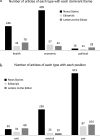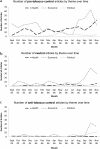Tobacco coverage in print media: the use of timing and themes by tobacco control supporters and opposition before a failed tobacco tax initiative
- PMID: 19965799
- PMCID: PMC2921260
- DOI: 10.1136/tc.2009.032516
Tobacco coverage in print media: the use of timing and themes by tobacco control supporters and opposition before a failed tobacco tax initiative
Abstract
Objective: Tobacco control policies gained ground nationwide in 2006, with voters in nine states approving legislation to strengthen clean indoor air policies and increase tobacco excise taxes. Despite having the second lowest cigarette tax rate in the nation, Missouri was unsuccessful in passing its 2006 ballot initiative to raise the tax. An important way to encourage health-related policy change such as increasing tobacco taxes is through media coverage of tobacco issues. We examined how tobacco issues were presented in Missouri's print media leading up to the 2006 election.
Methods: This study analysed 1263 articles with tobacco content published in 187 Missouri newspapers in the year before the election. Articles were coded for general and tobacco-related characteristics including article type (news story, editorial, letter to the editor), tobacco control position (pro, neutral, anti) and article theme (economic, health, political).
Results: Most articles were news stories (73.6%) and pro-tobacco control (63.8%). The proportion of anti-tobacco control articles increased significantly (chi(2)=104.9, p<0.001) the month before the election, driven by an increase in economically themed articles. Economic articles were published more often in counties with less voter support for the tax (F=5.68, p<0.01). Finally, tobacco control position varied significantly across article types (chi(2)=148.3, p<0.01), with letters to the editor being anti-tobacco control most often.
Conclusion: The media have a critical role in promoting public health goals and presenting health issues which influences formation of health policies. Tobacco control advocates must consider public opinion, opposition pressure, timing and themes in tobacco-related media coverage when promoting policy change.
Conflict of interest statement
Figures




Similar articles
-
Print media coverage around failed and successful tobacco tax initiatives: the South Carolina experience.Am J Health Promot. 2014 Sep-Oct;29(1):29-36. doi: 10.4278/ajhp.130104-QUAN-11. Epub 2014 Feb 20. Am J Health Promot. 2014. PMID: 24555442
-
Smoke-free workplace ballot campaigns: case studies from Missouri and lessons for policy and media advocacy.Am J Health Promot. 2013 Jul-Aug;27(6):e124-33. doi: 10.4278/ajhp.120405-QUAN-188. Epub 2013 Mar 4. Am J Health Promot. 2013. PMID: 23458373
-
Tobacco tax initiatives to prevent tobacco use: a study of eight statewide campaigns.Cancer. 1998 Dec 15;83(12 Suppl Robert):2666-79. doi: 10.1002/(sici)1097-0142(19981215)83:12a+<2666::aid-cncr2>3.3.co;2-2. Cancer. 1998. PMID: 9874375
-
Mobilising public opinion for the tobacco industry: the Consumer Tax Alliance and excise taxes.Tob Control. 2008 Oct;17(5):351-6. doi: 10.1136/tc.2008.025338. Epub 2008 Aug 7. Tob Control. 2008. PMID: 18687706 Free PMC article. Review.
-
[Tobacco control in South Africa].Promot Educ. 2005;Suppl 4:25-8, 57. doi: 10.1177/10253823050120040107. Promot Educ. 2005. PMID: 16190259 Review. French.
Cited by
-
Earned media and public engagement with CDC's "Tips from Former Smokers" campaign: an analysis of online news and blog coverage.J Med Internet Res. 2015 Jan 20;17(1):e12. doi: 10.2196/jmir.3645. J Med Internet Res. 2015. PMID: 25604520 Free PMC article.
-
Noncommunicable Diseases Prevention In Low- and Middle-Income Countries: An Overview of Health in All Policies (HiAP).Inquiry. 2021 Jan-Dec;58:46958020927885. doi: 10.1177/0046958020927885. Inquiry. 2021. PMID: 34420412 Free PMC article. Review.
-
Setting the agenda for a healthy retail environment: content analysis of US newspaper coverage of tobacco control policies affecting the point of sale, 2007-2014.Tob Control. 2017 Jul;26(4):406-414. doi: 10.1136/tobaccocontrol-2016-052998. Epub 2016 Jul 13. Tob Control. 2017. PMID: 27413061 Free PMC article.
-
Adolescent Support for Tobacco Control Policies and Associations with Tobacco Denormalization Beliefs and Harm Perceptions.Int J Environ Res Public Health. 2019 Jan 7;16(1):147. doi: 10.3390/ijerph16010147. Int J Environ Res Public Health. 2019. PMID: 30621115 Free PMC article.
-
The palatability of sugar-sweetened beverage taxation: A content analysis of newspaper coverage of the UK sugar debate.PLoS One. 2018 Dec 5;13(12):e0207576. doi: 10.1371/journal.pone.0207576. eCollection 2018. PLoS One. 2018. PMID: 30517133 Free PMC article.
References
-
- American Lung Association State of tobacco control 2006. New York, NY, Washington DC, 2006
-
- Centers for Disease Control and Prevention Best practices for comprehensive tobacco control programs - 2007. Atlanta, GA: Centers for Disease Control and Prevention, 2007
-
- Liang L, Chaloupka F, Nichter M, et al. Prices, policies and youth smoking, May 2001. Addiction 2003;98(suppl 1):105–22 - PubMed
-
- Stillman FA, Hartman AM, Graubard BI, et al. Evaluation of the American Stop Smoking Intervention Study (ASSIST): a report of outcomes. J Natl Cancer Inst 2003;95:1681–91 - PubMed
Publication types
MeSH terms
Substances
LinkOut - more resources
Full Text Sources
Medical
